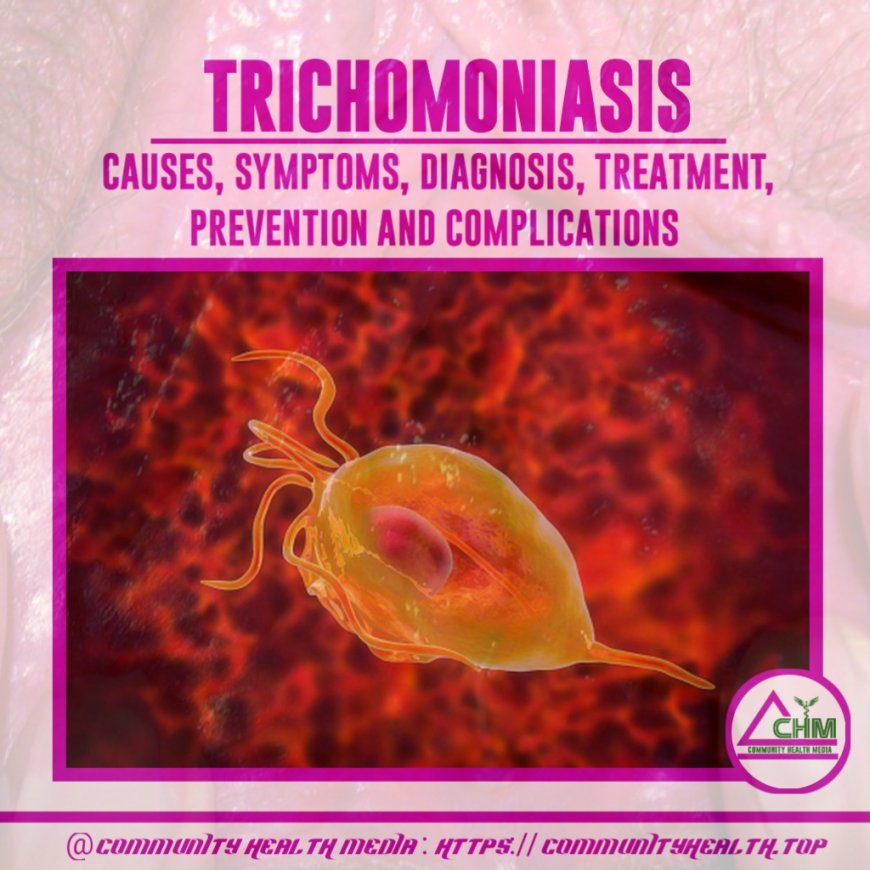Trichomoniasis : causes, symptoms, diagnosis treatment and prevention
Trichomoniasis is a sexually transmitted infection (STI) caused by a parasite called Trichomonas vaginalis. It is one of the most common STIs worldwide, affecting both men and women. In this blog post, we'll discuss the causes, symptoms, diagnosis, treatment, and prevention of Trichomoniasis.

Writes : Rchp. Abba Rabiu Sani / Reviewed : Murtala Muhammad Sa'id Ph.D
Overview:
Trichomoniasis is an STI caused by a parasite that spreads through sexual contact. It can affect both men and women, but symptoms are more common in women. In most cases, the infection is asymptomatic, but it can cause serious complications if left untreated.
Definition:
Trichomoniasis is a sexually transmitted infection caused by a parasite called Trichomonas vaginalis. It can cause inflammation of the genital tract in both men and women.
Classification:
Trichomoniasis is classified as a sexually transmitted infection (STI) and is caused by a parasitic protozoan called Trichomonas vaginalis.
Causes:
Trichomoniasis is caused by the Trichomonas vaginalis parasite, which is typically spread through sexual contact. The parasite can also survive outside the body for a short time and can be transmitted through shared towels, clothing, or other personal items.
Causative agent:
The causative agent of Trichomoniasis is the Trichomonas vaginalis parasite, which can infect the genital tract of both men and women.
Mode of transmission:
Trichomoniasis is typically spread through sexual contact, including vaginal, oral, or anal sex. It can also be transmitted through shared towels, clothing, or other personal items.
Incubation period:
The incubation period for Trichomoniasis can range from five to 28 days. However, some people may not develop symptoms for several months after infection.
Sign and symptoms:
In most cases, Trichomoniasis is asymptomatic, meaning that infected individuals may not experience any symptoms. However, when symptoms do occur, they typically include:
- Itching and irritation of the genitals
- Abnormal vaginal discharge (which may be thin and watery, frothy, or greenish-yellow)
- Pain or discomfort during sex or urination
- Swelling and redness of the genitals
- Foul-smelling vaginal odor
Diagnosis and test:
Trichomoniasis can be diagnosed through a variety of tests, including:
- A physical examination of the genital area
- A microscopic examination of vaginal or penile discharge
- A nucleic acid amplification test (NAAT), which detects the genetic material of the parasite in a urine or vaginal sample
- A culture test, which involves growing the parasite in a laboratory
Management and treatment:
Trichomoniasis can be treated with prescription medications, such as metronidazole or tinidazole. These medications are typically taken orally and are very effective in eliminating the parasite. Sexual partners should also be treated to prevent reinfection.
Risk factors:
Several factors can increase the risk of contracting Trichomoniasis, including:
- Having multiple sexual partners
- Engaging in unprotected sex
- Having a history of other STIs
Prevention and control:
The best way to prevent Trichomoniasis is to practice safe sex, which includes using condoms or dental dams during sexual activity. Other measures that can reduce the risk of infection include:
- Avoiding sharing personal items, such as towels or clothing, with others
- Getting tested regularly for STIs
- Being honest with sexual partners about your sexual history
Complications:
If left untreated, Trichomoniasis can cause several complications, including:
- Increased risk of other STIs: People who are infected with Trichomoniasis are more likely to contract other STIs, including HIV.
- Pregnancy complications: Pregnant women who are infected with Trichomoniasis may be at increased risk of premature delivery, low birth weight, and other pregnancy complications.
- Pelvic inflammatory disease (PID): In rare cases, Trichomoniasis can lead to pelvic inflammatory disease, which can cause chronic pelvic pain, infertility, and other complications.
Conclusion:
Trichomoniasis is a common STI caused by the Trichomonas vaginalis parasite. It is typically spread through sexual contact and can cause a range of symptoms, including itching, irritation, abnormal discharge, and pain during sex or urination. While most cases of Trichomoniasis are asymptomatic, the infection can cause serious complications if left untreated. Fortunately, Trichomoniasis can be easily diagnosed and treated with prescription medications. Prevention measures, such as practicing safe sex and getting tested regularly for STIs, can help reduce the risk of infection.
Outcome for infected people:
For people who are infected with Trichomoniasis, the outcome is generally good if the infection is detected and treated promptly. Prescription medications can effectively eliminate the parasite and relieve symptoms. However, if left untreated, Trichomoniasis can cause serious complications, including increased risk of other STIs, pregnancy complications, and pelvic inflammatory disease.
References:
- Centers for Disease Control and Prevention. (2023). Trichomoniasis - CDC Fact Sheet. https://www.cdc.gov/std/trichomonas/stdfact-trichomoniasis.htm
- Mayo Clinic. (2023). Trichomoniasis. https://www.mayoclinic.org/diseases-conditions/trichomoniasis/symptoms-causes/syc-20378609
- World Health Organization. (2022). Trichomoniasis. https://www.who.int/news-room/fact-sheets/detail/trichomoniasis

